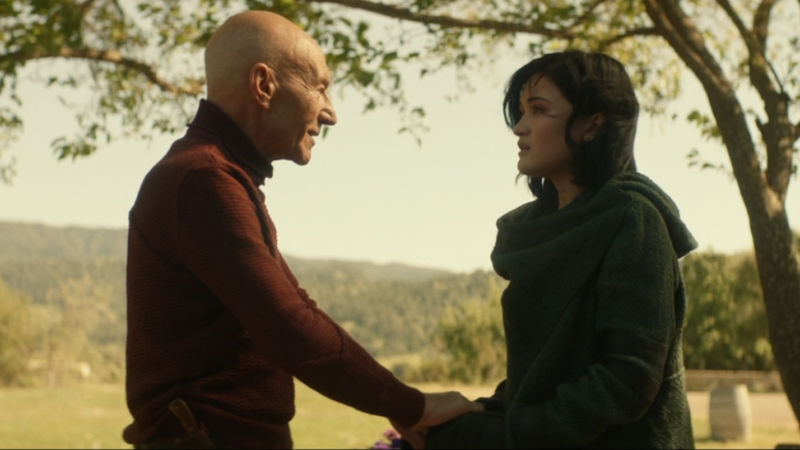
The first Romulan you meet in Star Trek: Picard speaks with a soft Gaelic accent and wears a comfortable, practical cardigan. She is the very model of a classic cozy housekeeper, an archetype made instantly recognizable by her bearing and manner, and yet in the same breath she's utterly foreign and unexpected.
This marriage of familiar with unfamiliar—this attempt to take what you know but then tilt it to one side and jiggle it around a bit to throw you off-balance—is as good a metaphor as any for what Picard seems to be doing. This is not the comfortable, well-worn world of Star Trek I was born and raised in and am now sharing with my own child. This is something different, and based on the first episode at least, I badly want to follow this path and see where it leads.
(Mild spoilers for the first episode of Picard, "Remembrance," follow below.)
The basics
The first episode of Picard moves exactly through the steps you would expect from watching the trailer. It dawns in a French vineyard, Château Picard, where the erstwhile captain has retired.
We of course know Jean-Luc Picard (Patrick Stewart) best as captain of the United Federation of Planets' flagship Enterprise. He helmed the Enterprise-D through seven seasons of television and one film, where its career as a spaceworthy vessel ended when half of it blew up and the other half crashed into a planet. After that, Picard took command of the Enterprise-E for three more films.
The events depicted in the last of those films, 2002's Star Trek: Nemesis, are the plot and emotional scaffolding over which the initial episode of Picard is draped. Most crucially, at the end of Nemesis, Lt. Commander Data chooses to sacrifice his life in order to save the lives of Picard and the rest of the Enterprise crew. Two decades later, the loss haunts Picard still. The show's cold open begins with Picard dreaming of a conversation with Data, and the episode returns often to that theme.
One other film, 2009's Star Trek, also looms large in Picard. That film, which rebooted the characters of the original series (Kirk, Spock, and so on) by forking them into an alternate timeline, posited that the alternate timeline was created when the star around which Romulus orbits went supernova in 2387. That disaster, we are told, precipitated the largest humanitarian effort in Starfleet history, when Picard coordinated and led a massive evacuation fleet to rescue as many Romulans—about 900 million, all told—as possible.
But those events are more than a decade gone in Picard, and life in the Burgundy countryside is a far cry from life aboard a starship. Even in the year 2399, the agricultural life is slow and grounded, in a very literal sense. This place, where Picard sought solace in years past while trying to recover psychologically from his time among the Borg, is as different from the hectic, maximum-warp, crisis-seeking speed of the Federation's flagship as it is possible to be.
In the first episode, Picard takes this grounding to heart. Except for a brief final scene teasing events for later in the season, we never leave the surface of the Earth or look out into the stars. Every episode of Star Trek: The Next Generation began with Stewart's stentorian tones exhorting us to come along on the Enterprise's continuing mission to seek out new life and new civilizations and boldly go where no-one has gone before, followed by a spectacular brass fanfare. But Picard is more subdued, instead keeping its gaze to the smaller world, accompanied by a haunting flute (a deliberate reference) and melancholy cello.
The end of the bucolic life arrives in the form of an enigmatic young woman going through a dramatic crisis. She arrives at Château Picard seeking safety, and Picard naturally provides it as best as he can. The mystery of her origin is revealed surprisingly swiftly, then given a twist. That twist clearly sets up what I can only think of as the main story quest, or at least a main story quest, for the rest of the season. And the episodes to come will presumably propel our heroes to recruit the crew of delightful misfits we've seen from the trailers, as well as other expected cameos from other members of the TNG cast.
The Federation might have begun as a largely human enterprise, but Earth and Starfleet are not synonymous, and the show wants us to feel that in every frame. Characters speak of time in calendar years, not in inscrutable coded stardates, and they speak these dates to each other, not to personal or ship's logs. The makeup, costume, and set design in particular are working overtime to wean us of the expectation The Next Generation set for us that the future would be full of track lighting and ugly unitards, a vision of utopia conceived through Gene Roddenberry's almost pathological level of optimism and visualized through all the synthetic fibers and beige interiors the 1980s could offer.
reader comments
335